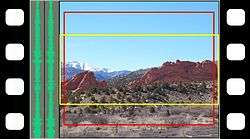Open matte

Open matte is a filming technique that involves matting out the top and bottom of the film frame in the movie projector (known as a soft matte) for the widescreen theatrical release and then scanning the film without a matte (at Academy ratio) for a full screen home video release.
Usually, non-anamorphic 4-perf films are filmed directly on the entire full frame silent aperture gate (1.33:1). When a married print is created, this frame is slightly re-cropped by the frame line and optical soundtrack down to Academy ratio (1.37:1). The movie projector then uses an aperture mask to soft matte the Academy frame to the intended aspect ratio (1.85:1 or 1.66:1). When the 4:3 fullscreen video master is created, many filmmakers may prefer to use the full Academy frame ("open matte") instead of creating a pan and scan version from within the 1.85 framing. Because the framing is increased vertically in the open matte process, the decision to use it needs to be made prior to shooting, so that the camera operator can frame for 1.85:1 and "protect" for 4:3; otherwise unintended objects such as boom microphones, cables, and light stands may appear in the open matte frame, thus requiring some amount of pan and scan in some or all scenes. Additionally, the unmatted 4:3 version will often throw off an otherwise tightly-framed shot and add an inordinate amount of headroom above actors (particularly with 1.85:1).
Many films over the years have used this technique, the most prominent of which include Schindler's List and Top Gun. Stanley Kubrick also used this technique for his last five films.